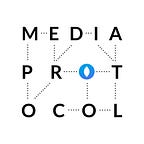MEDIA Protocol And Blockchain Security — Part 7
The team here at MEDIA Protocol are deeply committed to creating a more direct, transparent and secure ecosystem for content creators, publishers, and consumers through the revolutionary application of blockchain technology. We’re here to connect the worlds of marketing and technology for everyone’s benefit.
We’ve got love for both worlds, but from our own experience we know that they can sometimes feel, literally, worlds apart. So we’re committed, not just to connecting them, but to creating a common understanding between them.
This series of articles aims to explain the ins and outs of blockchain security to help everyone — the marketeers, the technologists, and the content consumers — understand the principles behind this game-changing technology.
We want to help educate by demystifying the potential applications of blockchain technology. Most importantly, we feel it’s vital to highlight and clarify the security elements of blockchain; how it safeguards data, enables open and transparent record-keeping and ensures secure digital transactions.
Strap in, and welcome to the MEDIA Protocol Blockchain Education Programme.
Part 7 — Improved Confidentiality And Data Integrity
If it can be proven that data has not been manipulated or spoofed, that data is said to have retained its integrity.
How Do We Test Data Integrity?
The clearest way to test data integrity is by using ALCOA.
This acronym explores the different elements required in order to confirm data integrity. Effectively, the data must be: Attributable, Legible, Contemporaneous, Original, and Accurate.
By applying this method to data stored and transmitted via the blockchain we can see how the technology meets each of these requirements:
- Attributable — every transaction and state change in the data’s history is retained, right back to the original source.
- Legible — digital inputs are almost always legible, and data can be validated on input to make sure it’s in a readable format.
- Contemporaneous — data can be time-stamped to verify when it was last altered. Blockchain updates are close to real-time across the network.
- Original — again, data can be traced right back to its source. With the distributed ledger and no single owner, it cannot readily be tampered with.
- Accurate — data on the blockchain can be validated, e.g. with a smart contract.
How Is Confidentiality Improved?
By decentralizing storage across a network of nodes it is close to impossible for specific data to be targeted by hackers. Similarly, data in transit is also fully encrypted with hash cryptography.
This reduces the chance of Man in the Middle (MiTM) attacks to almost zero. These attacks are a form of digital eavesdropping, where a bad actor inserts themselves, unseen, into a channel of communication between two users at two different data points.
By intercepting the messages they send one another, and substituting their own public key for those of the genuine actors, malicious users can interfere with and steal data that was never intended to be shared outside of the two parties originally interacting with the expectation of full confidentiality.
With the data fully encrypted before sending on either end, the bad actor in the middle is far less able to intercept or decrypt the data. More importantly, attempts to intercept can be detected and weeded out by:
- Authentication — using secure channels and key-agreement protocols that encrypt the data.
- Tamper detection — monitoring latency, and discrepancies in response times will flag any attempts to intercept.
How Does This Extend To The IoT?
The Internet of Things (IoT), otherwise known as appliances and other technology with online connectivity for their sensors, comes with its own security and accessibility issues.
IBM are tackling this on their Watson platform by offering users the capability to manage their data on a private blockchain. This will also integrate with Big Blue cloud storage, providing a more secure way to store data remotely.
That data can include the most personal of information, for example medical records. Due to the enhanced security of blockchain, IBM are now forging forward with ways to make the platform a secure system for patients and doctors to exchange healthcare information on the spot, replacing less efficient and vulnerable medical record systems.
Ericsson’s Blockchain Data Integrity service provides verifiable, compliant data to GE to allow them to make apps using the best quality data. This is done via the Predix PaaS platform, and using their own Keyless Signature Infrastructure — KSI™, they have simplified the process of encrypting data even further, all thanks to the underlying blockchain. This generates digital signatures that are irreversible.
Ultimately, the blockchain’s distributed ledger system means that even if one node is targeted or fails, it doesn’t provide access for tampering. These developments are made possible because third parties are no longer required to establish trust.
MEDIA Protocol Harnesses This Blockchain Security
Your transactions and interactions using MEDIA Protocol will be protected by these same security features. You can trust in the integrity of the data you send and receive, and be confident that your information remains confidential, even while transmitting.
For more in-depth looks at the blockchain security features, take a look at the rest of our articles in this series:
Part 1 — Blockchain: Is It Secure?
Part 2 — How Does Blockchain Apply To Cyber Security?
Part 3 — How Does Blockchain Create Transparency?
Part 4 — How Blockchain Ensures That No-One Can Impersonate The Owner Of An Address
Part 5 — Different Ways Of Handling Real-world Identity On The Blockchain
Part 6 — What Sybil Attacks Are And Possible Mitigations
Part 7 — Improved Confidentiality and Data Integrity (This article above)
For more information regarding MEDIA Protocol find us on our social channels below:
Website: www.mediaprotocol.org
Facebook: https://www.facebook.com/MEDIAProtocol
Twitter: https://twitter.com/MEDIA_Protocol
LinkedIn: https://www.linkedin.com/company/media-protocol/
Telegram: https://t.me/Media_Protocol_Community and https://t.me/MP_Announcements
